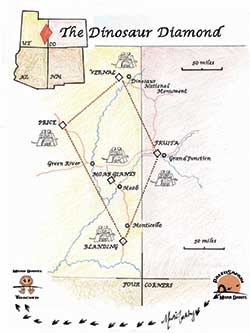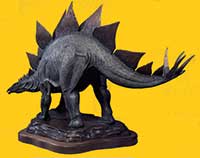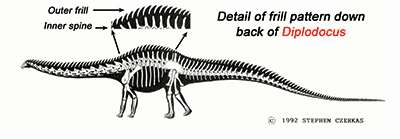 |
| Map of the Dinosaur Diamond showing dinosaur museums at all corners. Map available at Moab Giants. |
We may sell our beloved region short if we think of only one ‘Dinosaur Diamond.’ The area so labelled is studded with paleontological and geological gems. The region’s various fossil treasures make up a glittering diadem, an array of paleontological wealth built around a Mesozoic core of crown jewels: AKA the “Age of Dinosaurs.” In Moab Happenings (April 2020) we celebrated the beauty of Triassic painted deserts and gem-quality fossil wood. Today we arrive in the Jurassic, tomb of many world-famous dinosaurs, like Allosaurus and Stegosaurus. So, how about a fact-finding tour?
*The Dinosaur Diamond has a Jurassic framework or setting known to science for more than a century. In 1900 what was then, the world’s largest dinosaur, Jurassic Brachiosaurus, was discovered, on July 4th, in Grand Junction, by Elmer Riggs from the Chicago Field Museum. It created a sensation when reconstructed as if looking into a fifth story high rise window. A full-sized skeleton is centrally placed at Chicago’s O’Hare airport: Thanks Elmer, you helped create the diamond’s eastern facet!
**Jurassic bones from what is now Dinosaur National Monument were discovered near Jensen Utah in 1909, by Earl Douglass from the Carnegie Museum. The rest is “googleable” dinosaur history. Some 300,000 people visit the world’s most famous Jurassic quarry each year. Thanks Earl, you created the diamond’s northern facet, and helped christen the world’s only town named Dinosaur. Thanks also to Scottish-American philanthropist Andrew Carnegie for funding paleontology and distributing full-sized replicas to the world’s museums. He said to die rich was a disgrace: i.e., you can’t take dinosaurs or diamonds with you.
*** In 1927 shepherds stumbled across dinosaur bones not far from Price, Utah. Thanks, shepherds!. Today the site known as the Cleveland Lloyd Quarry claims to contain the densest concentration of dinosaur bones anywhere: mostly all the predator Allosaurus, also the Utah State fossil. Most interpret the site as a quagmire death trap. A single egg, that was never laid, appears to have survived inside a mommy allosaur. Thanks to coal mining around Price, Carbon County and Carbon College (later the College of Eastern Utah: CEU) got their names, and the CEU Prehistoric museum was created at the diamond’s western apex. The paleontological gems of coal mining history are for a future Moab Happenings chapter on the Cretaceous.
 |
| Sculpture of Stegosaurus with correct arrangements of facet-shaped plates was first made by Stephen Czerkas, co-creator of the Blanding Museum. |
****The Jurassic Diadem’s earliest discovery, Dystrophaeus (Moab Happenings, June 2020) made by the early Macomb expedition of 1859, was also whisked off back east to the National Museum (Smithsonian) in DC, and, having only recently been properly excavated, is still having its frills and facets cleaned up by Utah-based paleontologists. Interred for 150 + million years, it took 150 + years to dig it up!. The remote site qualifies, historically, as the diamond’s southern apex. But speaking of frills and facets, no gem is presentable until expertly finished, and so we must turn to the Dinosaur Museum, Blanding. The late Stephen Czerkas and his wife Sylvia, current museum director, spent their careers creating this paleontological gem. Thanks Czerkas! Stephen is best-known for revealing what dinosaurs really looked like. Believe it or not, the arrangement of plates on the Stegosaurus, and the mid-line frill down back of Diplodocus were unknown or wrongly reconstructed until Steve gave them both a 21st century makeover. His authentic reconstructions toured the world and sent leading paleo artists scurrying back to their drawing boards. If you live in, or visit the Dinosaur Diamond, don’t overlook the facet that is the Moab Giants Museum – with a new generation of sculptures informed by the likes of Stephen Czerkas, but be advised: you don’t really know it all in depth until you explore the Blanding gem that puts the sparkle on the facet at its southern apex.
 |
| The sauropod dinosaur Diplodocus had a zig-zag frill down its back, above the spine. Stephen Czerkas, co-creator of the Blanding Museum, discovered this feature by study of skin impressions. |
|


